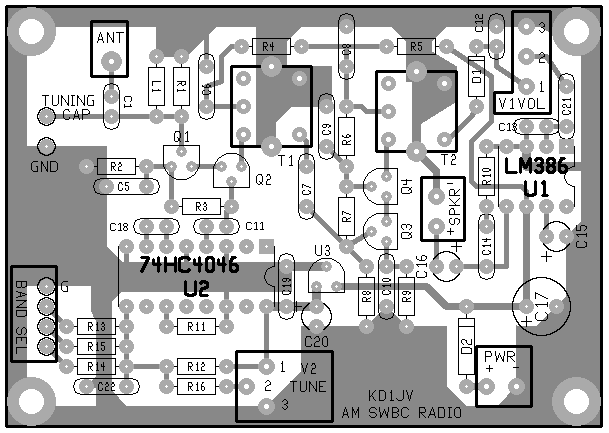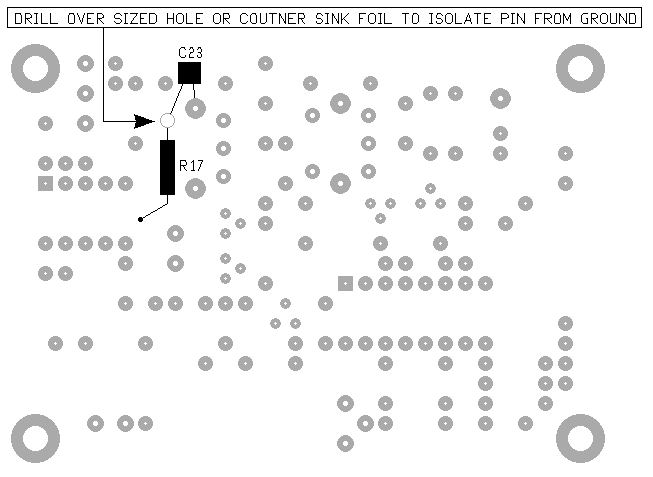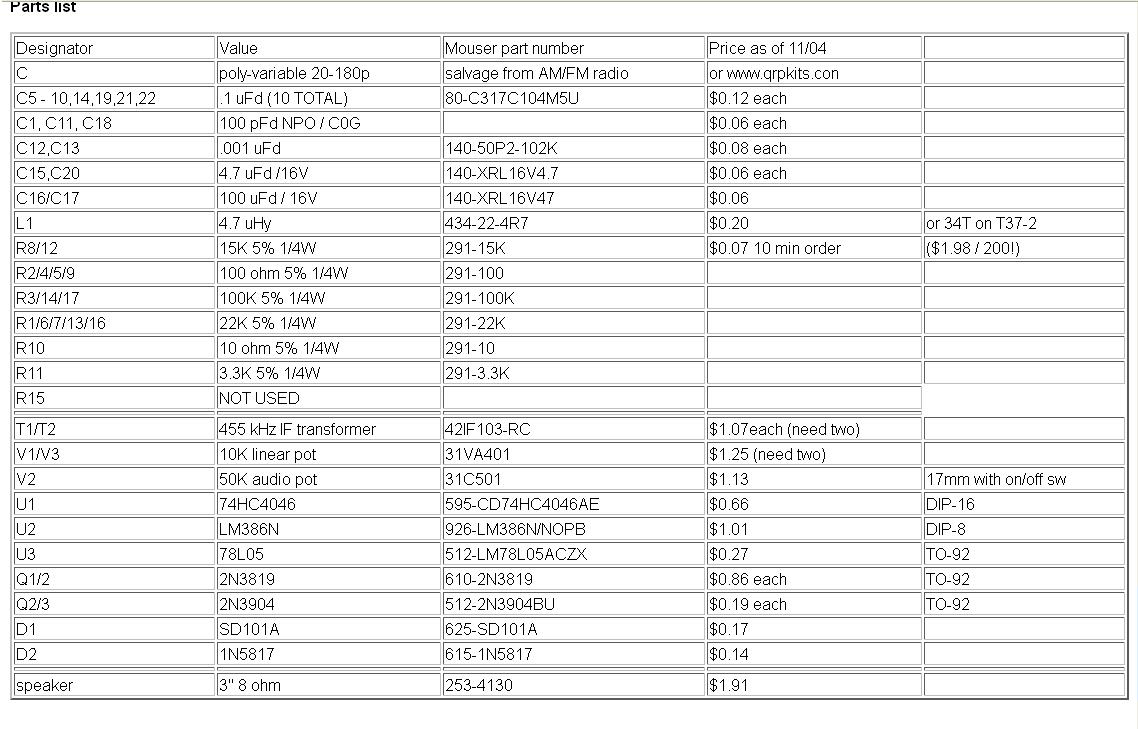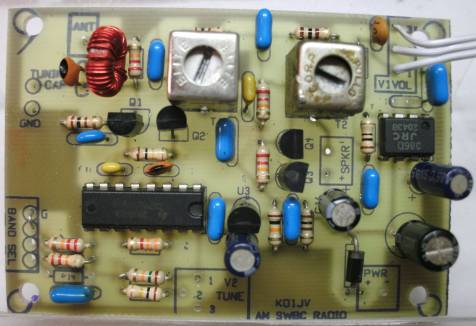
تبلیغات

موضوعات

جستجو

پیوندهای روزانه

لینک دوستان
- دریافت رایگان این قالب
- سایت عاشقانه ماندگار فان
- سایت عاشقانه عشق آفرین
- جامعه رادیو اماتوری ایران
- سازمان تنظيم مقررات و ارتباطات راديوئي
- شرکت اروم الکترونیک
- فروشگاه قطعات الكترونيكي
- ARRL • Devoted Entirely to Amateur Radio
- درددل های یک بازنشسته
- نخستین سایت آموزشی رادیو آماتوری در ایران
- نشریات آماتوری
- EP2MRD
- QRZCQ - The database for radio hams
- شناسه تخصيص نحوه دستورالعمل ايستگاه به ارتباط راديويي هاي ) Call Sign ( دستورالعمل ارتباط شناسه تخصيص نحوه ايستگاه به راديويي
- رادیو آماتوری
- کلوپ رادیو آماتوری ایرانیان
- ارسال لینک

صفحات جانبی

امکانات جانبی
 آمار
وب سایت:
آمار
وب سایت:
بازدید دیروز : 7575
بازدید هفته : 21111
بازدید ماه : 23757
بازدید کل : 2255967
تعداد مطالب : 673
تعداد نظرات : 121
تعداد آنلاین : 1
Simple, low cost AM SWBC Receiver
This project has been updated. This design was originally published 10 years ago (2004) and since then several parts have become discontiuned and no longer available. The part numbers for many of the parts have changed so they come up as "not found" when you go looking for them. Since FAR circuits recently made up some boards for this project, I decided it was time to update the information.
This AM Short Wave Broadcast Receiver is a reasonably simple, but effective design and can be built at low cost. It requires no adjustments to get to work and is more or less fool proof. This makes it a great beginners project, with little or no test equipment. The radio can be built for about $20.00, even if all new parts need to be bought. Many of the parts can be salvaged from an old AM/FM transistor or clock radio.
The radio will drive a small speaker to a comfortable volume. It will work with a short wire (3 feet or longer) or telescoping antenna. Tuning range is about 5.5 MHz to 10 MHz, using a coarse and fine tuning control. The radio can be powered by a 9 volt battery and draws about 21 ma of current. I would recomment using AA batteries or a small 9V AC adaptor to power the radio, as 9V radio batteries are expensive and won't last too long.
How it works:
The antenna is coupled into the mixer through C1, 100 pfd. The input to the mixer is tuned to about the receive frequency of interest by L1 and a poly-variable cap. The tuning cap can be a little hard to find as a new part, but can be salvaged from a dead or cheap AM/FM radio. (Poly-variables are available from qrpkits.com )
The mixer is an active stage using two JFETs in a cascode configuration. 2N3819's are shown, but just about any N channel JFET will work. The circuit was shamelessly borrowed from experimental Methods of RF Design" by W7OZI and co-anthers. This mixer exhibits about 13 dB of conversion gain. It requires a large amplitude Local Oscillator drive, which makes directly coupling to the square wave output of the 74HC4046 VCO quite acceptable.
The output of the mixer is tuned to the IF frequency of 455 kHz by the IF transformer T1. This is coupled into a cascode amplifier consisting of Q2 and Q3. This amplifier basically combines a common emitter amplifier to which the input signal is coupled to, with a common base amplifier which adds additional gain, but keeps the amplifier quite stable. The output of this stage is again tuned with a 455 kHz IF transformer. The combination of the two IF transformers gives the radio some selectivity.
The AM signal is detected by a Shottky diode on the output of T2. A Shottky is used due to its low forward drop voltage, which reduces the level needed to detect a signal by at least 3 times over a silicon diode. The diode is connected to the volume control, which in turn goes to a LM386 audio amp. Forward bias was added to the detector diode to improve small signal sensitity and improves the audio quality. R17 supplies the bias and C23 by-passes the RF. These parts need to be added to the bottom of the circuit board.
The Local Oscillator uses the Voltage tuned R/C oscillator section of a 74HC4046 PLL. This part is capable of generating a signal up to about 30 MHz. C18 and R11 comprise the R/C part of the oscillator. The R/C oscillator isn't very stable and constantly bounces around a few 100 Hz. Fortunetly, the wide bandwidth of the IF and the nature of AM modulation is such that the instablility is not noticable to any great extent.
The original design was set up to just tune three SWBC bands and used a bank of three resistors selected by a switch to set the center of the tuning frequency to those bands. The TI chip tunes a wider frequency range so the voltages which need to be set for each band become farily close to each other, making it difficult to come up with standard values for the divider. Plus there is the problem of parts tollerances which will cause the exact voltages needed for a specific frequency to vary unit to unit.
The best way to solve this delema was simply to make continues tuning. Spaning large frequency range with a single turn pot makes for some very touchy tuning, so a fine tune control was added. Or you could use a 10 turn pot, but those are expensive. Trimmer resistors could have been used to set the center frequency for each band, but the board was not set up for that and now that boards have been made, too late to change.
WARNING: Not all 74HC4046s are created equal. The values shown are for the CD74HC4046N made by Texas Insturments (which is currently the only supplier of new through hole versions of this part). Parts made by a different manufacturer will require different values. Probably radically different values. The origninal CMOS 4046 parts will not work, as they have a much lower maximum operating frequency.
Construction:
Parts list and assembly drawings at bottom of page.
If you can make your own circuit boards, the layout and component location screen is avaiable as SWBC_PCB.pdf . A premade circuit board is also available from FAR Circuits for $5.00. (note, if you get the FAR board, there is a missing hole for one of the pins for T2 which you will have to drill).
Assembly is straight forward. It is easiest to start with the resistors, then the IC's, then the caps and so on. Note that the lead spacing for the resistors is very tight for 1/4 W resistors. You may want to use 1/8 W instead.
Adding some forward bias to the detector diode improves sensitivity and fidelity of the received signal. This is done be isolating the normally grounded pin of T2 secondary and adding a resistor between the pin and plus supply and adding a bypass cap between the pin and ground. Since the hole for this pin is missing from the board supplied by FAR curcuits, using a common 1/16" drill bit to make the hole should be big enough. Just be careful not to short to the foil around the hole when adding the components to the pin. You could also use an XACTO knife to cut the foil.
A frequency counter can be connected to pin 4 of U2, the 74HC4046. This is a 5 volt square wave. A 6 digit LED counter with programable IF offset can be bought direct from China for about $15US. This makes a nice digial dial, but draws an additional 90 ma. Set the dial for negative IF offset. In this mode, it will add the IF offset to the VFO frequency. Note that these counters clip the input to 600 mv with diode clamps which will load down the output of the '4046. In this case, add a series resistor of 3.3K or there abouts bewteen the coutner input and 4046 output.
The two IF transformers should come set close enough to the same frequency so they don't need adjustment. But if you must (and we must) try and peak the signals, adjust just one transformer and NEVER touch the other. Otherwise, you will chase the center frequency up and down the adjustment range of the coils!
The input tuning is sharp enough that it will require frequent re-peaking as the coarse frequency is tuned up and down the tuning range.


Parts list
| Designator | Value | Mouser part number | Price as of 11/04 | |
| C | poly-variable 20-180p | salvage from AM/FM radio | or www.qrpkits.con | |
| C5 - 10,14,19,21,22 | .1 uFd (10 TOTAL) | 80-C317C104M5U | $0.12 each | |
| C1, C11, C18 | 100 pFd NPO / C0G | $0.06 each | ||
| C12,C13 | .001 uFd | 140-50P2-102K | $0.08 each | |
| C15,C20 | 4.7 uFd /16V | 140-XRL16V4.7 | $0.06 each | |
| C16/C17 | 100 uFd / 16V | 140-XRL16V47 | $0.06 | |
| L1 | 4.7 uHy | 434-22-4R7 | $0.20 | or 34T on T37-2 |
| R8/12 | 15K 5% 1/4W | 291-15K | $0.07 10 min order | ($1.98 / 200!) |
| R2/4/5/9 | 100 ohm 5% 1/4W | 291-100 | ||
| R3/14/17 | 100K 5% 1/4W | 291-100K | ||
| R1/6/7/13/16 | 22K 5% 1/4W | 291-22K | ||
| R10 | 10 ohm 5% 1/4W | 291-10 | ||
| R11 | 3.3K 5% 1/4W | 291-3.3K |  |
|
| R15 | NOT USED | |||
| T1/T2 | 455 kHz IF transformer | 42IF103-RC | $1.07each (need two) | |
| V1/V3 | 10K linear pot | 31VA401 | $1.25 (need two) | |
| V2 | 50K audio pot | 31C501 | $1.13 | 17mm with on/off sw |
| U1 | 74HC4046 | 595-CD74HC4046AE | $0.66 | DIP-16 |
| U2 | LM386N | 926-LM386N/NOPB | $1.01 | DIP-8 |
| U3 | 78L05 | 512-LM78L05ACZX | $0.27 | TO-92 |
| Q1/2 | 2N3819 | 610-2N3819 | $0.86 each | TO-92 |
| Q2/3 | 2N3904 | 512-2N3904BU | $0.19 each | TO-92 |
| D1 | SD101A | 625-SD101A | $0.17 | |
| D2 | 1N5817 | 615-1N5817 | $0.14 | |
| speaker | 3" 8 ohm | 253-4130 | $1.91 |

ورود کاربران

عضويت سريع

پشتيباني آنلاين

آمار

خبرنامه

آخرین نطرات کاربران
 جواد یاور مطلق - درود
جواد یاور مطلق - درود بلا بدور باشه مهندس !
انشالله همیشه سرحال سالم تندرست باشید !
پاسخ:با درود و سپاس از لطف شما دوست گرامی بدرود - 1403/1/29
 یک هم وطن - من بدون مدار این رادیو ساختم باصدای واضح و بلند بدون برق و باطری
یک هم وطن - من بدون مدار این رادیو ساختم باصدای واضح و بلند بدون برق و باطری پاسخ:باتشکر از لطفتان امیدوارم بقیه دوستان هم همت کنند و دست به اچار و هویه شده خودشان بسازند و لذت ساختن را ببرند چون در داشتن لذت نیست هنر ساختن است - 1402/6/13
 AEC - درود
AEC - دروداستاد ممنون خیلی خوب و عالی
پاسخ:باسلام و تشکر از لطف و مرحمت شما دوست عزیز و گرامی - 1400/8/28
 پرویز مهرزاد - سلام ودرود استاد عبدالحق عزیز بسیار خوشحالم که سایت جنابعالی بامطالب جدید وعالی دوباره فعلیتش را شروع نموده است.
پرویز مهرزاد - سلام ودرود استاد عبدالحق عزیز بسیار خوشحالم که سایت جنابعالی بامطالب جدید وعالی دوباره فعلیتش را شروع نموده است.پاسخ:با سلام تذکر بجا و بموقعی بود بسیار متشکرم - 1400/8/28
 ایزدی - یه مشکلی داره این طرح. کل سلف ها با هم 12. 7 میکرو میشه که با خازن 270 پیکو، فرکانس مرکزی فیلتر 2.7 مگا هرتز می شه. کمترین سلف هم (0.1 میکرو) با همون خازن 270 پیکو 30 مگاهرتز رو رد می کنه. بنا بر این نیازی به خازن های دیگه نیست. دوستان دیگه نظرشون چیه.
ایزدی - یه مشکلی داره این طرح. کل سلف ها با هم 12. 7 میکرو میشه که با خازن 270 پیکو، فرکانس مرکزی فیلتر 2.7 مگا هرتز می شه. کمترین سلف هم (0.1 میکرو) با همون خازن 270 پیکو 30 مگاهرتز رو رد می کنه. بنا بر این نیازی به خازن های دیگه نیست. دوستان دیگه نظرشون چیه.پاسخ:باسلام و تشکر کل خازن ها و سلفها برای فرکانس 1800کیلو که ابتدای باند رادیو اماتوری است کم است و بسختی تنظیم می شود اما برای 3500 بله زیاد است - 1399/8/24
 هومن - سلام .علت استقبال نکردن در خور توجه همین نا واردیست .این مطلب بسیار گنگ و پر از اشتباه هست
هومن - سلام .علت استقبال نکردن در خور توجه همین نا واردیست .این مطلب بسیار گنگ و پر از اشتباه هست پاسخ: سلام بنده هم ضمن تائید نظر شما درخواست می کنم مطلب کامل تر و بهتر و درست تر را بفرمائید بنده بنام خودتان درج و منتشر نمایم
پاسخ:https://t.me/joinchat/AAAAAEJj30AwLGIyi_UQ3g مدارات لامپی - 1396/12/17
 علی - سلام شما مکتبی و انقلابی هستید درسته ؟
علی - سلام شما مکتبی و انقلابی هستید درسته ؟پاسخ: سلام بهیچ عنوان و تقریبا هیچ جائی من چنین ادعائی نکرده ام اما این همه شهید و زخمی و جانباز و اسیر و زحمت و فعالیت برای حفظ انقلاب و سرزمین عزیزمان ایران خیلی حرام لقه گی و بی اصل و نصبی می خواهد که چشم خودرا ببندیم و از این اب و خاک حمایت و به این مردم عشق نورزیم حالا شما اسم انرا هرچه دوست دارید بگذارید نظرتان محترم است - 1396/12/17
 هومن - سلام
هومن - سلام بنده یکی از علاقمندان لامپ هستم . و 10 سال اخیر را بر روی مدارات لامپی کار کردم .با سرچ اینجا را پیدا کردم .می خواستم ببینم در زمینه مخابرات فعالیت لامپی در ایران هست ؟
این مطلب راجب لامپ واقعا توجه مخاطب علاقمند را جلب می کند ؟
من فکر می کنم نویسنده اصلا راجب لامپ حس خوبی ندارد .عذر خواهی می کنم
پاسخ:سلام دوست عزیز از صراحت و فصاحت بیان شما خوشحالم مطلبتان راجع به نویسنده مطلب لامپ کمی کم لطفی و شاید سخت گیری در بر دارد نویسنده مطلب استاد عاملی بزرگ رادیو اماتوری ایران هستند و مطلب را بی اندازه ساده و اسان گفتند چون اکثر جوانها از لامپ و ولتاژ کار ان وحشت داشته و تقریبا هیچ نمی دانند اما ظاهرا شما در مورد لامپ مطلع و ازموده هستید لذا برخود نگیرید شما هم اگر در مورد لامپ و یا مطالب استاد عاملی نقد و نظری دارید بسیار خوشحال می شوم مکتوب بفرمایید تا در همان بخش یا در بخش جدید بنام خودتان منتشر شود
پاسخ:https://t.me/joinchat/AAAAAEJj30AwLGIyi_UQ3g - 1396/12/16
 سعیدی - سلام استاد بنده بی جواب ماندم
سعیدی - سلام استاد بنده بی جواب ماندم پاسخ:با سلام و پوزش از تاخیر طبق تجربه دوستان این مدار به دلیل نامرغوب بودن قطعات نو موجود در بازار معمولا در ابتدا کار نمی کند لذا بتوصیه استاد عاملی بهنر است از قطعات اوراقی رادیو و ضبط ها استفاده شود قطعات معمولا در گیر این رادیو ابتدا ای سی سویچ یا کلید زنی است که یک مدل خاصش برای مدار مناسب است و مدلهای دیگر فرکانس کار و ولتاژشان مناسب نیست درمورد ای سی مدولاتور و دمدولاتور 3028 این ای سی هم بشدت مورد شک و شبهه است در موردی باتعویض 5 عدد ای سی دو عدد که بهتر بود در مدار بکار گرفته شد لذا بهترین روش استفاده از مرحله مرحله و گام بگام کار کردن رادیو است ضمن انکه اگر فرستنده کار بیفتد گیرنده هم کار خواهد کرد و بالعکس لذا شما می توانید مدار را از میکروفون در حالت فرستنده یا بلندگو در حالت گیرنده شروع نمایید و اگر مسیر سیگنال جدا باشد در نقشه شما می توانید از تقویت صدا شروع کرده و به دمدولاتور رفته و سپس به فیلتر و بعد میکسر وی اف او و در اخر به فیلتر تنظیم باند بروید و حد اکثر سیگنال و حساسیت را بدست اورید پس فیلتر های رادیویی یا بقول شما توکو ها قسمت اخر تنظیم و تعقیب مدارتان است اگر شد برای اطلاع شما و سایر دوستان مدار را در حالت گیرنده و فرستنده جدا اراعه خواهم داد یا با رنگ مسیر سیگنال را جدا می کنم که راحت تر باشد اگر شما عضو تلگرام هستید در یکی از گروه های رادیو اماتوری بیایید و مستقیما با دوستان سازنده و استفاده کننده رادیو تماس گرفته راهنمایی شوید اگر نه ادرس ایمیلتان را بدهید تا راهنمای مونتاژ را برایتان بفرستم
پاسخ:http://py2ohh.w2c.com.br/trx/ararinhamontagem/montandoararinha.htm
راحل مونتاژ و تست مدار است - 1396/11/5
آرشیو
- تير 1403
- مهر 1402
- ارديبهشت 1401
- دی 1400
- آبان 1400
- ارديبهشت 1399
- اسفند 1397
- آذر 1397
- آبان 1397
- خرداد 1397
- ارديبهشت 1397
- فروردين 1397
- اسفند 1396
- بهمن 1396
- دی 1396
- آذر 1396
- آبان 1396
- شهريور 1396
- مرداد 1396
- تير 1396
- خرداد 1396
- ارديبهشت 1396
- فروردين 1396
- اسفند 1395
- بهمن 1395
- دی 1395
- آذر 1395
- آبان 1395
- مهر 1395
- شهريور 1395
- مرداد 1395
- تير 1395
- خرداد 1395
- ارديبهشت 1395
- فروردين 1395
- اسفند 1394
- بهمن 1394
- دی 1394
- آذر 1394
- آبان 1394
- مهر 1394
- شهريور 1394
- مرداد 1394
- تير 1394
- خرداد 1394
- ارديبهشت 1394
- فروردين 1394
- اسفند 1393
- بهمن 1393
- دی 1393
- آذر 1393
- آبان 1393
- مهر 1393
- شهريور 1393
- مرداد 1393
- تير 1393
- خرداد 1393
- ارديبهشت 1393
- فروردين 1393
- اسفند 1392
- بهمن 1392
- دی 1392
- آذر 1392

